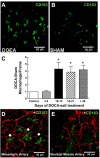Macrophage depletion lowers blood pressure and restores sympathetic nerve α2-adrenergic receptor function in mesenteric arteries of DOCA-salt hypertensive rats
- PMID: 26320034
- PMCID: PMC4666925
- DOI: 10.1152/ajpheart.00283.2015
Macrophage depletion lowers blood pressure and restores sympathetic nerve α2-adrenergic receptor function in mesenteric arteries of DOCA-salt hypertensive rats
Abstract
We tested the hypothesis that vascular macrophage infiltration and O2 (-) release impairs sympathetic nerve α2-adrenergic autoreceptor (α2AR) function in mesenteric arteries (MAs) of DOCA-salt hypertensive rats. Male rats were uninephrectomized or sham operated (sham). DOCA pellets were implanted subcutaneously in uninephrectomized rats who were provided high-salt drinking water or high-salt water with apocynin. Sham rats received tap water. Blood pressure was measured using radiotelemetry. Treatment of sham and DOCA-salt rats with liposome-encapsulated clodronate was used to deplete macrophages. After 3-5, 10-13, and 18-21 days of DOCA-salt treatment, MAs and peritoneal fluid were harvested from euthanized rats. Norepinephrine (NE) release from periarterial sympathetic nerves was measured in vitro using amperometry with microelectrodes. Macrophage infiltration into MAs as well as TNF-α and p22(phox) were measured using immunohistochemistry. Peritoneal macrophage activation was measured by flow cytometry. O2 (-) was measured using dihydroethidium staining. Hypertension developed over 28 days, and apocynin reduced blood pressure on days 18-21. O2 (-) and macrophage infiltration were greater in DOCA-salt MAs compared with sham MAs after day 10. Peritoneal macrophage activation occurred after day 10 in DOCA-salt rats. Macrophages expressing TNF-α and p22(phox) were localized near sympathetic nerves. Impaired α2AR function and increased NE release from sympathetic nerves occurred in MAs from DOCA-salt rats after day 18. Macrophage depletion reduced blood pressure and vascular O2 (-) while restoring α2AR function in DOCA-salt rats. Macrophage infiltration into the vascular adventitia contributes to increased blood pressure in DOCA-salt rats by releasing O2 (-), which disrupts α2AR function, causing enhanced NE release from sympathetic nerves.
Keywords: amperometry; immune activation; salt-sensitive hypertension; sympathetic nervous system; α2-adrenergic autoreceptors.
Copyright © 2015 the American Physiological Society.
Figures









Similar articles
-
Macrophage-dependent impairment of α2-adrenergic autoreceptor inhibition of Ca2+ channels in sympathetic neurons from DOCA-salt but not high-fat diet-induced hypertensive rats.Am J Physiol Heart Circ Physiol. 2018 Apr 1;314(4):H863-H877. doi: 10.1152/ajpheart.00536.2017. Epub 2018 Jan 5. Am J Physiol Heart Circ Physiol. 2018. PMID: 29351460 Free PMC article.
-
Antioxidant treatment restores prejunctional regulation of purinergic transmission in mesenteric arteries of deoxycorticosterone acetate-salt hypertensive rats.Neuroscience. 2010 Jun 30;168(2):335-45. doi: 10.1016/j.neuroscience.2010.03.061. Epub 2010 Apr 14. Neuroscience. 2010. PMID: 20398741 Free PMC article.
-
Impaired function of alpha2-adrenergic autoreceptors on sympathetic nerves associated with mesenteric arteries and veins in DOCA-salt hypertension.Am J Physiol Heart Circ Physiol. 2004 Apr;286(4):H1558-64. doi: 10.1152/ajpheart.00592.2003. Epub 2003 Dec 11. Am J Physiol Heart Circ Physiol. 2004. PMID: 14670814
-
Does the kidney influence the hunger for salt?Kidney Int. 2024 Dec;106(6):1025-1028. doi: 10.1016/j.kint.2024.09.009. Kidney Int. 2024. PMID: 39577987 Review.
-
Serotonin-induced ion channel modulations in mesenteric artery myocytes from normotensive and DOCA-salt hypertensive rats.J Smooth Muscle Res. 2007 Jun;43(3):85-97. doi: 10.1540/jsmr.43.85. J Smooth Muscle Res. 2007. PMID: 17721045 Review.
Cited by
-
Mineralocorticoid receptor antagonists in diabetic kidney disease - mechanistic and therapeutic effects.Nat Rev Nephrol. 2022 Jan;18(1):56-70. doi: 10.1038/s41581-021-00490-8. Epub 2021 Oct 21. Nat Rev Nephrol. 2022. PMID: 34675379 Review.
-
Immunity and Hypertension.Acta Physiol (Oxf). 2021 Jan;231(1):e13487. doi: 10.1111/apha.13487. Epub 2020 Jun 25. Acta Physiol (Oxf). 2021. PMID: 32359222 Free PMC article. Review.
-
Recruitment of macrophages from the spleen contributes to myocardial fibrosis and hypertension induced by angiotensin II.J Renin Angiotensin Aldosterone Syst. 2017 Apr-Jun;18(2):1470320317706653. doi: 10.1177/1470320317706653. J Renin Angiotensin Aldosterone Syst. 2017. PMID: 28490219 Free PMC article.
-
New actions of an old friend: perivascular adipose tissue's adrenergic mechanisms.Br J Pharmacol. 2017 Oct;174(20):3454-3465. doi: 10.1111/bph.13663. Epub 2016 Dec 4. Br J Pharmacol. 2017. PMID: 27813085 Free PMC article. Review.
-
Angiotensin-II activates vascular inflammasome and induces vascular damage.Vascul Pharmacol. 2021 Aug;139:106881. doi: 10.1016/j.vph.2021.106881. Epub 2021 Jun 9. Vascul Pharmacol. 2021. PMID: 34098096 Free PMC article.
References
-
- Asghar M, Banday AA, Fardoun RZ, Lokhandwala MF. Hydrogen peroxide causes uncoupling of dopamine D1-like receptors from G proteins via a mechanism involving protein kinase C and G-protein-coupled receptor kinase 2. Free Radic Biol Med 40: 13–20, 2006. - PubMed
-
- Bouvier M, de Champlain J. Increased basal and reactive plasma norepinephrine and epinephrine levels in awake DOCA-salt hypertensive rats. J Auton Nerv Syst 15: 191–195, 1986. - PubMed
-
- Chan CT, Moore JP, Budzyn K, Guida E, Diep H, Vinh A, Jones ES, Widdop RE, Armitage JA, Sakkal S, Ricardo SD, Sobey CG, Drummond GR. Reversal of vascular macrophage accumulation and hypertension by a CCR2 antagonist in deoxycorticosterone/salt-treated mice. Hypertension 60: 1207–1212, 2012. - PubMed
Publication types
MeSH terms
Substances
Grants and funding
LinkOut - more resources
Full Text Sources
Other Literature Sources
Medical
Miscellaneous

